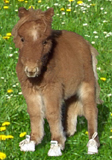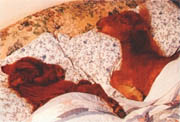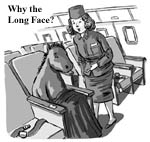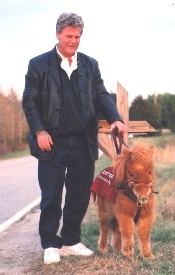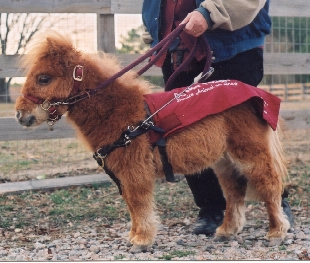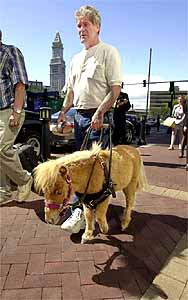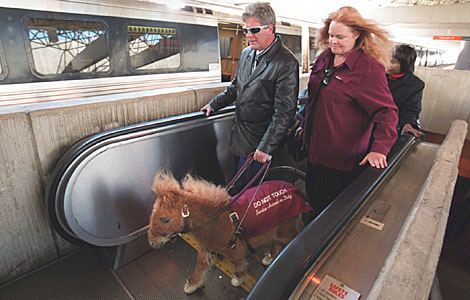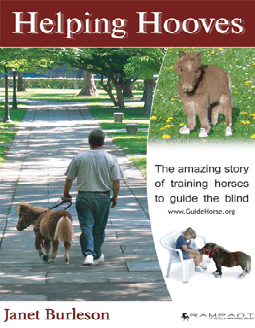|
|
Foundation hopes to blaze happy trails for the blind
KITTRELL, N.C. -- Janet Burleson gets the strangest looks when she takes Tonto for a walk. It's unusual enough that she's walking a miniature horse. But Tonto's outfit is equally odd: Instead of horseshoes and a saddle, she wears little white tennis shoes and a maroon blanket that reads, "Do Not Touch. Service Animal on Duty." Burleson is training Tonto to guide the blind.
In a few months, Burleson hopes the year-old American miniature will become her second working guide horse. For now, Burleson is working on basic voice commands, stopping every couple of minutes to put Tonto's shoes back on or scoop up her droppings. Burleson says miniature horses like Tonto simply give blind people a mobility alternative to a guide dog. But some guide-dog users and trainers are wary of a program they see as more cutesy than practical for the blind. Burleson is a retired professional horse trainer with 35 years experience. She came up with the idea of training guide horses five years ago when she noticed how her own pet miniature horse, Twinkie, carefully guided her around obstacles at a busy flea market. The idea gained ground while she was on a trip months later, watching with surprise as rented carriage horses in Central Park stayed calm even in Manhattan traffic. She recalled a blind woman she knew from horse shows, and remembered being impressed at the relationship between the woman and the horse. "It seemed like a natural fit," she said. In 1999, Burleson and her husband, Don, started the Guide Horse Foundation at their 20-acre farm in Kittrell, 35 miles northeast of Raleigh. They began training Twinkie to obey voice commands, and by 2000 the horse was skilled enough for a demonstration on the "Ripley's Believe It or Not" TV show. They were soon flooded with calls from blind people. Dan Shaw, a 46-year-old from Ellsworth, Maine, was one of those people. He has retinitis pigmentosa, which has reduced his sight to pinhole vision in one eye. He considered getting a guide dog but couldn't bear the thought of parting with it after the typical eight-to 10-year service life. Miniature horses, by contrast, live 30 to 40 years. Within months, the Burlesons picked out a horse named Cuddles to train for Shaw. Burleson has no formal training to school guide animals. She teaches the horses to respond to voice commands, avoid stationary and moving obstacles, and shift their bodies to notify the person they're guiding of steps or hills. "We worked side by side with blind people and observed how they interacted with dogs," and modeled the program after that, she said. Burleson keeps about 20 miniature horses. Tonto and seven other horses belong to the foundation, and Burleson will spend nine months to a year apiece training them. The others are pets. Each prospective guide horse must be in good health, have strong legs, be less than 26 inches tall and be able to walk at least 10 continuous miles. They must also pass tests demonstrating they're alert to the environment, sociable and can navigate detours to reach a goal. Miniature horses have excellent vision, great memories and a calm nature, Burleson said. She believes they're ideal for people who love horses, are allergic to dogs or don't want an indoor pet. She agrees they're not for everybody. "We've always emphasized choice," she said. "Most of the people who contact us already love horses. We consider it an experimental program because we only have one animal placed as a guide." The proven quality of dogs as guides, established by more than 70 years of their use in service, and the absence of proof that horses will succeed has created skepticism among guide-dog trainers. "Everybody gets captivated by the cute," said Suzanne Whalen, president of National Association of Guide Dog Users. "And cute's OK. But . . . it's a life-and-death situation." Whalen disputes Burleson's claim that horses will naturally avoid a dangerous situation. "That's great only if the horse and the blind person agree on what's dangerous," Whalen said, recalling a time when she tried to ignore her German Shepherd's order to stop as she attempted to cross a busy street. She knew she had a green light, yet Caddo suddenly threw himself in front of her power wheelchair, preventing her from moving forward just as a bus whizzed past. "I'm not saying that horse wouldn't do that, but why take that chance?" she said. Whalen also questioned whether a horse's longer life is necessarily a benefit. "Having an animal live for 30 years if it can't meet your needs is not an advantage." She also notes that horses require an owner to live in a rural area. They can't curl up and lie under a restaurant table or in the back seat of a car, and they can't hold their waste as long as a dog can. Shaw scoffs at those arguments. While Cuddles lives in a small barn Shaw built in his yard, the 25-inch, 80-pound horse is housebroken and trained to tap her hoofs on the door if she needs to go out. "She's everywhere we've ever gone, public and nonpublic," Shaw said, including restaurants, hospitals and malls. She's ridden on escalators, boats and airplanes, even subways. Those white tennis shoes -- modified baby sneakers -- prevent her from falling on slippery surfaces. He recalls one trip he and Cuddles took to New York City while in training, during which they rode the subway several times. "Sometimes it would be as crowded as a packed sardine can," he said. "It never bothered her. The whole thing -- the screeching of the trains or the people on the stairs -- none of that bothered her." The Burlesons acknowledge their idea is in its infancy. "We're not really in a hurry to turn this into a major industry," Don Burleson said. "Safety is our priority. The blind people literally entrust us with their lives."
|
||||||||
Guides Training Press Photos News Apply FAQ Wishes Contact Home
|
|
Copyright © 1998 - 2005 by the Guide Horse Foundation Inc. Guide Horse ® Guidehorse ® and Helping Hooves ® are registered trademarks. |
The Guide Horse Foundation has the utmost respect for The Seeing Eye® and their seventy-two years of outstanding work with assistance animals for the blind. Even though the press often calls our horses "seeing eye horses", please note that The Guide Horse Foundation is not affiliated with or sanctioned by the Seeing-Eye® or any of the Guide Dog training organizations. Seeing-Eye® is a registered trademark of the Seeing-Eye, Inc.
